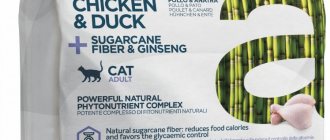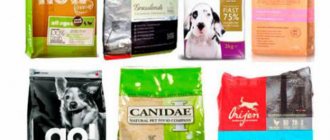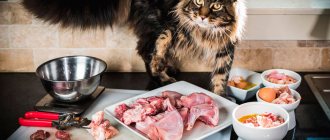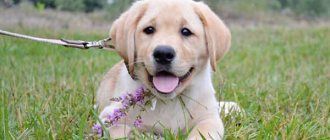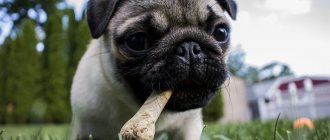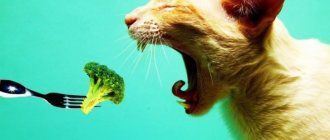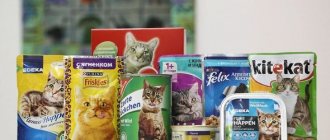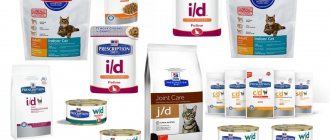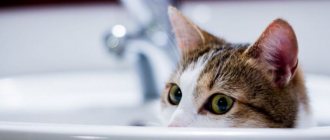Rating of holistic food for cats
The purpose of the rating is to provide a list of high-quality, safe, healthy holistic food products. To do this, we studied more than 100 customer reviews, based on which 20 popular diets were selected. Consultations with veterinarians, as well as owners of cats of different breeds, helped eliminate weak candidates.
During the selection, special attention was paid to the following characteristics:
- Type – dry or wet;
- Age – for kittens, adults or seniors;
- The ratio of proteins, fats, carbohydrates;
- Taste, aroma;
- Energy value;
- Therapeutic effect;
- Natural composition;
- Humidity level;
- Size, shape of granules (for dry mixtures);
- Weight, type of packaging, presence of a zip lock.
Consumption, shelf life, commercial availability, and versatility were also taken into account. The result of careful analysis and comparison was the TOP list, which included 10 leaders. The remaining nominees were not included in the best rating due to poor absorption, causing allergic reactions, addiction, and also because of the high price and relatively low quality.
What is holistic food?
The name of the product comes from the Greek language. Translated into Russian, holism means “whole.” This term was first used by the German manufacturer Innova Evo. By doing this, he emphasized the importance of a product made from the best ingredients.
Holistic class cat food is the best type of nutrition developed by nutritionists. During production, genetic and nutritional principles are taken into account. By regularly eating this product, animals replenish their nutritional requirements and receive all the necessary minerals and vitamins without the slightest harm.
Joseph Coquitt, the founder of the Golden Eagle brand, was the first to think about healthy eating for pets. Thanks to him, the composition of the product has become safe even for humans.
Differences from other foods
At first, holistic specialists were included in the super-premium class, but due to the strong difference in quality, they were quickly assigned to a separate category. They differ from other classes in the following compositional features:
- Squirrels
. The protein component is represented by ingredients of plant and animal origin. The first include corn gluten, pea and potato protein. The second group includes moisture-deprived meat and low-fat fish.
- Carbohydrates
. The inclusion of potatoes, peas, lentils and rice is acceptable. Corn and wheat are useless to the animal, so they can only be seen in lower rated products.
- Cellulose
. Dietary fiber is necessary for comfortable digestion, but even in the premium class it may be missing. For a holistic class, this element is required. It is represented by dried apples, carrots or beet pulp.
- Vitamins and minerals
. Enzymes, probiotics, omegas and other vital supplements can be found here. There is no need to use additional drugs.
- Preservatives
. Preservation helps prolong the freshness and life of the product, so its exclusion will affect the quality. Manufacturers use tocopherols – preservatives of natural origin. Any synthetic additives, even flavor enhancers, are excluded.
Plant ingredients make up no more than 10%, so the cat gets most of its nutrients from meat, as it should in the wild. Thanks to this, the price for the holistic class is almost 2 times higher than for the premium class.
Advantages and disadvantages
In addition to its balanced and safe composition, the holistic class has other advantages. These include:
- high nutritional value and cost-effectiveness (recommended servings are smaller than in economy class);
- variety of granule sizes, allowing you to choose food for different ages;
- natural ingredients that prevent allergies.
Among the disadvantages, it is worth noting the high cost and low distribution. Food is not sold in chain stores, so it can only be purchased at a veterinary clinic or on the Internet.
Due to the lack of flavors, it may be difficult to change your diet. Pets who grew up on Whiskas and Kitekat will treat the new dish with distrust.
If you have diseases of the urinary system or at least a genetic predisposition to such pathologies, feeding holistically can be dangerous. The abundance of proteins overloads the kidneys and liver, causing pathological changes in their structure. Therefore, before switching to holistic, it is recommended to get tested and consult a veterinarian.
How to choose holistic food for a cat
When choosing a holistic specialist, you should definitely determine the required number of kilocalories for your pet, taking into account its weight, age, as well as activity level and body type. Next, it is important to pay attention to the energy value of the feed. The amount of serving required for a particular animal depends on this indicator. To avoid mistakes, it is better to use special tables on product packaging or websites.
Type
There are 2 types of food: dry, wet. The advantage of the first option is convenient storage and feeding. The granules will not spoil if they sit in a bowl all day. Thanks to this, the animal can eat food often and in small portions, which is especially important for busy owners.
Wet diets have a more pronounced smell, so they are suitable for even the most picky pets. Their feature is to maintain an adequate level of fluid in the body, thereby reducing the likelihood of diseases (problems with the urinary tract, kidneys).
Animal age
For kittens (up to 1 year), diets with a high content of probiotics, proteins, and enzymes are suitable. They are needed for the proper formation of the skeleton and muscle corset.
Excess, as well as deficiency, of vitamins, fats, carbohydrates and proteins has a detrimental effect on the health of adult cats (from 1 to 6 years). Therefore, it is better to choose specialized formulations that contain the optimal amount of all useful components. In older pets (from 7 years old), metabolism deteriorates and kidney efficiency decreases. In this case, it is better to choose food with a relatively low content of fats, proteins, as well as low-calorie, easily digestible carbohydrates, and vitamins.
Special Needs
Hypoallergenic formulations are suitable for animals prone to allergies and food intolerance. To reduce the risk of obesity and urolithiasis, holistic food for sterilized cats is enriched with mineral and organic substances.
The diet for pregnant and lactating women has a high content of nutrients and vitamins. For active, sedentary pets, high-calorie and low-calorie diets are intended, respectively.
Type of packaging
To preserve the nutritional value and taste of dry food, the strength, tightness, light and moisture resistance of the packaging are important. The most reliable way to store such mixtures is to use a polyethylene bag, the inside of which is foil or metallized. It is important to pay attention to the presence of a zip fastener.
You can store wet rations in tetra packs, jars, lamisters, and spiders. The first option is relevant for long-term storage. A jar is suitable for feeding at home. The optimal solution for one-time feeding is lamister. Pouches are very convenient to take on the road.
Texture
Dry granules perfectly remove plaque and tartar and ensure the proper functioning of the dental system. The soft consistency is better absorbed and is suitable for cats with inflammation of the gums and teeth.
Characteristics of food Holistic
The name of this class comes from the Greek word “Holism”, meaning “everything”, “whole”, “common”. There is such a concept in philosophy. Aristotle’s famous saying from his treatise Metaphysics states: “Integrity is more than the sum of its parts.”
From the point of view of animal nutrition, these principles suggest that “Holistic” is not only a set of specific components and substances, but also a general whole that has better properties than any other food. These are new generation mixtures made from products intended for people using special technologies.
The ingredients in these foods are selected taking into account the concepts of nutrigenomics - a science guided by the principles of genetics and nutrition. All products are considered from the point of view of their effect on the heredity and health of living beings. “Human” gene diets are also known, created according to the principles of testing detoxification, lipid metabolism, vitamin B, folic acid, calcium, insulin, and oxidative stress.
The founder and popularizer of healthy food for pets, Joseph Coquitt, was the first to put forward the postulate - “We are what we eat.” He stated that only natural ingredients can be beneficial for pets (cats and dogs).
Which holistic food is best for cats?
To feed domestic predators, veterinarians recommend using both dry and wet formulations. Combined nutrition is better absorbed and maximally enriches the cat’s body with all the necessary vitamins, minerals, antioxidants, amino acids and fiber.
When choosing a holistic practitioner, you should consider the needs of the animal:
- Now Fresh is relevant for spayed and sterilized pets.
- If you are looking for a universal option that will suit kittens, adult and older cats, then you should buy GO! Skin+Coat.
- The best choice for preventing urolithiasis is Summit Three Meat Indoor Cat Recipe.
- Picky animals will definitely appreciate the combination of tuna and chicken in Almo Nature Classic.
- You can combine porridge with Solid Natura.
- For an exclusively meat-based diet, grain-free Applaws is suitable.
- If high nutritional value is your priority, then be sure to check out Prime Ever 3B.
Natural nutrition with an ideal balance of proteins, fats and carbohydrates on an ongoing basis is the key to a pet’s well-being, good health, and longevity. The review presented the safest, highest quality, nutritious, delicious mixtures at an affordable price.
Types of holistic feeds
- Dry. This type is considered the most popular, probably because its cost is much lower than wet. It also lasts 1.5-2 times longer compared to wet canned food.
- Wet. Canned food is more suitable for adult or older cats.
- For kittens. The composition is calculated perfectly, all the necessary components are strictly calculated. This food promotes rapid growth of the cat. In appearance it differs only in the size of the granules and pieces of meat.
- For older cats. He often specializes in the treatment of many diseases. Therefore, you can purchase this diet with a prescription from a veterinarian. Such diets are sold exclusively in branded stores or veterinary pharmacies.
Age recommendations
By age it is divided into 3 main categories:
- kittens up to 1 year;
- adult cats aged from 1 to 6 years;
- older cats over 6 years old.
It is important to buy the one that suits the age of your pet. Because they are intended for a certain age, and their composition is completely different. For example, kitten food contains more vitamins and carbohydrates for faster development, and adult food contains more calcium to strengthen bones.

